Biomass Cofiring: A Promising New Generation Option
Biomass cofiring has the potential to cut emissions from coal-fueled generation without substantially increasing costs or infrastructure investments. Research shows that when implemented at relatively low biomass-to-coal ratios, energy consumption, solid waste generation, and emissions are all reduced. However, mixing biomass and coal does create some challenges that must be addressed.
Some pioneering power generators are branching out into renewable fuels by cofiring biomass with coal. Biomass can include a wide range of biological materials from tree branches and wood wastes to agricultural residues (Figures 1 and 2). Two key advantages of using biomass to help generate electricity are that it is a renewable energy source that helps cut air emissions, and it can be grown over a relatively short period of time.
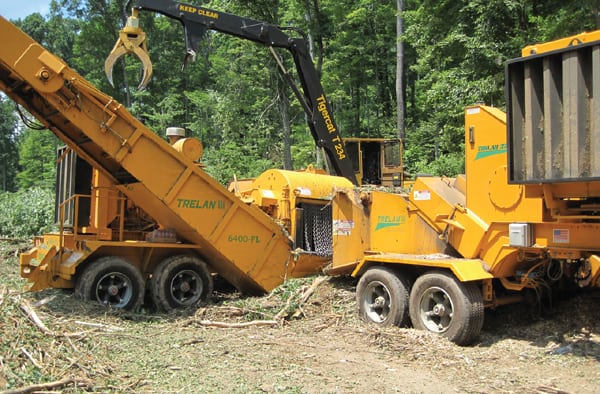 |
| 1. Wood work. This is a typical in-forest chipping operation. Courtesy: Enviro-Burn Inc. |
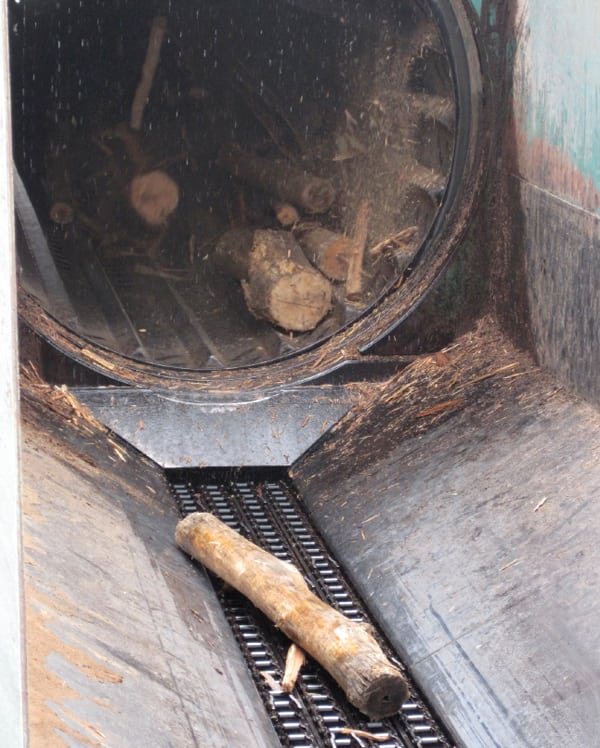 |
| 2. Peeling away the bark. The large-scale tree de-barking operation helps to create the renewable fuel. Courtesy: Enviro-Burn Inc. |
“The hope is that cofiring biomass will aid in meeting state renewable portfolio standards and provide the positive aspects of biomass cofiring, including reducing greenhouse gas (GHG) emissions,” Jason Hayes, MEDes, communications director for the American Coal Council, told POWER in February. “These cofiring options offer utilities a workable renewable baseload solution. They have the potential to give utilities the option of meeting renewable electricity standards with their existing baseload fleet of coal-fired power plants.”
The Basics of Biomass Cofiring
Biomass is derived from living or recently living organisms, Hayes explained. Although fossil fuels are also derived from plant or living organisms, the primary difference in makeup—as it relates to GHG emissions—is one of time scale. Fossil fuels removed carbon from the atmosphere many centuries ago, whereas biomass has the potential to remove carbon from the atmosphere as it grows today or in the very near future.
Purpose-grown biomass can be tailored to have low alkali levels to mitigate typical biomass boiler slagging concerns. Additionally, engineered coal fuels now offer coal and biomass briquette/pellet options, which improve the energy density and reduce the grindability, supply, and handling challenges typically associated with biomass (see sidebar).
The primary reason for cofiring biomass with coal is that it is a means of reducing the potential environmental impacts associated with the combustion of fossil fuels. Given that cofiring requires large amounts of biomass fuels, cofiring typically works best at large coal-fueled plants that have materials-handling capability already on-site (Figures 3 and 4). However, other industrial users—such as cement plants—could also make use of biomass cofiring.
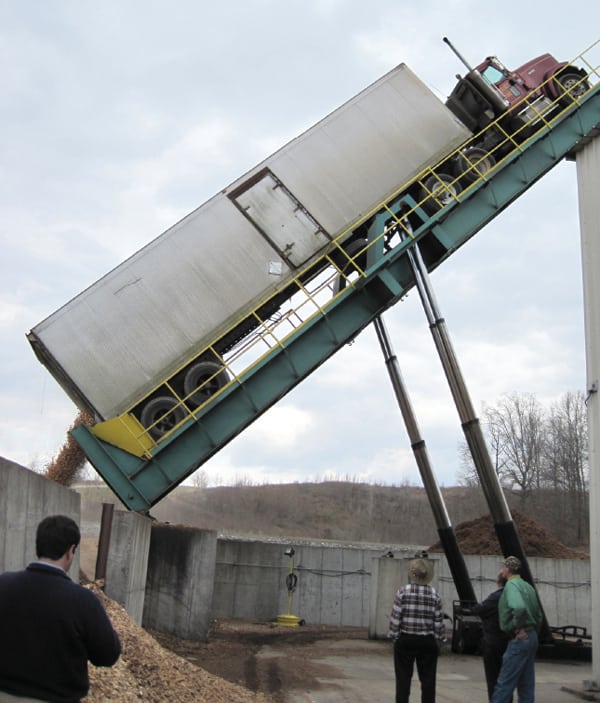 |
| 3. Lightening the load. This photo shows an unloading operation at a typical wood chip receiving facility. Courtesy: Enviro-Burn Inc. |
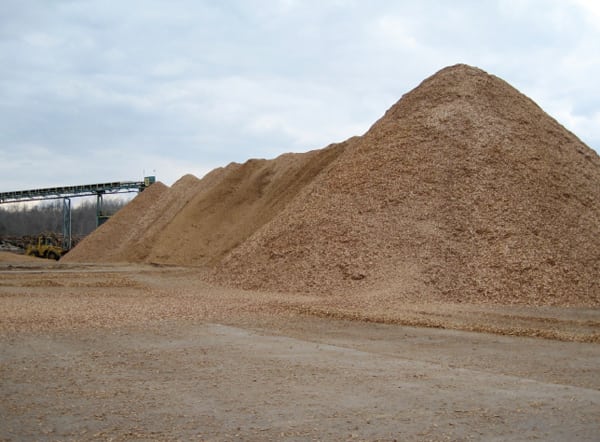 |
| 4. Tree power. This centralized chipping/storage yard contains mounds of utility-grade wood chips ready to be used as fuel. Courtesy: Enviro-Burn Inc. |
Three types of cofiring are in use around the world, Hayes explained:
- Direct cofiring is the simplest of the three and the most commonly chosen option. In this version of cofiring, more than one type of fuel is placed in a furnace/boiler at a time (Figure 5). The same or separate feed systems, mills, and burners can be used, depending on the fuel characteristics.
- Indirect cofiring involves converting biomass from a solid fuel to a gaseous form before firing. The gas is then burned in the same furnace/boiler as the coal.
- Separate biomass firing occurs when a separate biomass boiler is added to the overall system to bolster the steam capacity of an existing boiler.
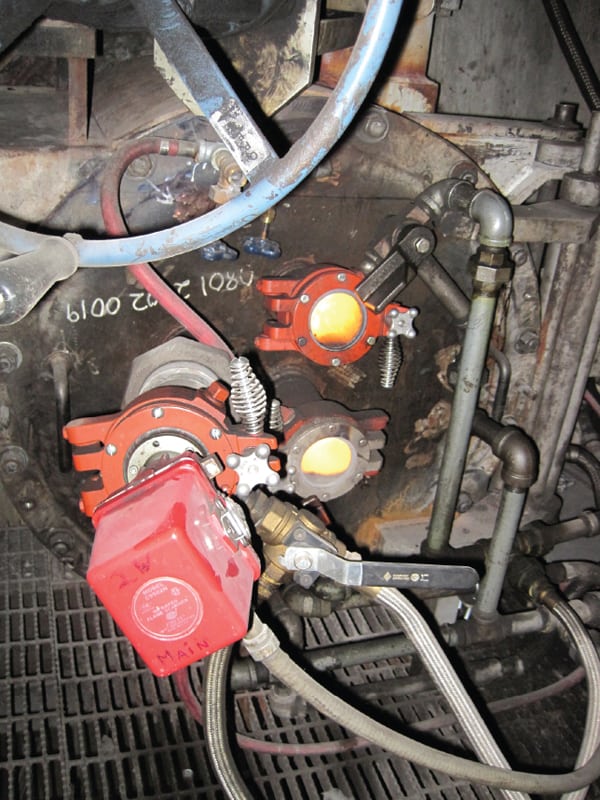 |
| 5. Adding fuel to the fire. Enviro-Burn Inc. recently conducted a cofiring test burn of biomass in a utility-scale boiler. Courtesy: Enviro-Burn Inc. |
The Benefits of Cofiring Biomass with Coal
Dr. Marco J. Castaldi, assistant professor in the Earth & Environmental Engineering Department at Columbia University in New York City, shared with POWER his perspective on the advantages of cofiring biomass with coal.
“The benefits primarily are life-cycle carbon dioxide (CO2) reductions,” he said. “Another benefit of cofiring is that it reduces sulfur and mercury emissions because biomass is virtually free of sulfur and mercury. In addition, higher hydrogen and oxygen content can give better combustion efficiencies (that is, better burnout). Finally, cofiring enables fuel diversity and local supply of fuel if possible markets for agricultural waste exist.”
Dr. Ashwani Gupta, director of Propulsion and Energy, AIAA, and professor in the Department of Mechanical Engineering at the University of Maryland, also talked to POWER about the benefits of cofiring biomass under the right conditions.
“The material-handling cost is significant,” he said. “So if the material-handling facility already exists to handle biomass, then this adds attractive economical benefits of biomass cofiring. This also reduces the upfront costs of handling biomass.”
Hayes outlined what the American Coal Council considers to be the key advantages that biomass cofiring can offer to operators of coal-fired power plants under the right circumstances:
- Biomass can use existing infrastructure investments for fossil fuels.
- Actual fuel costs can be very low—even free—as biomass producers are often happy to be rid of what they consider “waste.”
- Biomass costs compare favorably with those of other renewable options.
- The addition of biomass to a coal-fueled boiler is likely to have little or no negative impact on generation efficiency (depending on the fuel preparation measures taken).
- With proper fuel selection and management, overall emissions of sulfur oxides, nitrogen oxides (NOx), and mercury—as well as net GHG emissions—can be reduced. Biomass is typically nearly free of sulfur and mercury, so these emissions are reduced in proportion to its use; NOx emissions may fall or rise slightly, depending on boiler operation.
- Biomass is considered to be “carbon-neutral,” so its use can result in a proportional reduction in GHG emissions.
Overcoming Operational Challenges
Despite its many benefits, biomass cofiring also can present challenges due to important fuel-handling differences compared with coal. Successful biomass plants have to design their fuel systems to deal with specific biomass fuel properties and characteristics (see “Designing Fuel Systems for Large Biomass Plants,” February 2011, available in our archives at https://www.powermag.com).
Biomass creates issues of boiler slagging and fouling, according to Gupta. Success in firing biomass with coal is very boiler-dependent and fuel-dependent. Unfortunately, too few full-blown cofiring operations exist to provide information on how to alleviate fouling and deposition problems. These challenges have been handled on an individual basis, according to experiences with specific boilers.
“For example, with PRB [Powder River Basin] coal, there are some experiences that can be extended to cofiring biomass with PRB coal,” Gupta said. “The coal industry is reluctant to invest unless there is demonstrated technology available that can be used, or the payback time is relatively short (less than three years) on the return on investment. The federal government must invest in technology development and demonstration experiences that can then be used for different kinds of boilers and loads.”
Gupta noted that problems related to supplying biomass materials to coal-fired power plants include sustaining the supply and quality of biomass over time. Costs associated with transporting the material from its source to the plant are also an issue.
Castaldi agreed that there are major challenges related to delivering a steady supply of consistent material. Another problem: “The ash characteristics are very different,” Castaldi said. “Adding biomass can reduce the ash-melting temperatures and cause more slagging. Also, biomass typically has a higher moisture content than coal and therefore can clog equipment when burned. The sizing of biomass particles can also be an issue.”
Usually, biomass particles are slightly larger than coal particles and may not be able to be pulverized to the same specifications as the coal, Castaldi explained. Biomass that does not meet these specifications is likely to cause flow problems in the fuel-handling equipment or incomplete burnout in the boiler. In addition, the mineral content of biomass is very different than coal’s and can cause major corrosion problems.
The American Coal Council has compiled its own list of problems related to biomass cofiring:
- As with other renewable energy sources, biomass cannot compete on an economic footing with coal (or other fossil energies) due to low thermal efficiency, high cost, variable impacts on boiler and milling equipment, and high technical risk.
- Biomass typically has low bulk energy density, is wet and strongly hydrophilic, and therefore, requires a great deal of fuel-handling technology compared to its heating contribution.
- Although fuel costs may be low, transportation, preparation, and handling costs for biomass can rapidly exceed total fuel costs for other fossil fuel options.
- Potential exists for increased corrosion rates in boilers due to higher alkali levels in biomass fuel.
- Biomass fuels can contain as much as 50% moisture. This is important because moisture in a boiler will reduce efficiencies.
- Ash fusion temperatures for most biomass fuels are far lower than coal ash fusion temperatures (as low as 750C vs. over 1,000C for coal). Consequently, there is a strong possibility that the rate and extent of boiler slagging will increase.
- Negative impacts on fly ash usability result because current ASTM specifications require that fly ash be derived wholly from coal combustion. Initial tests indicate a need for updating this ASTM specification as biomass-containing fly ashes behave in a manner similar to coal-only fly ashes.
- European tests indicate that cofiring with biomass can have a significant negative impact on selective catalytic reduction (SCR) (deactivation) if not managed properly.
Biomass Cofiring Projects
Despite the many challenges associated with cofiring biomass with coal, a number of feasibility projects both in the U.S. and other countries have achieved some success.
“There are many successful dedicated small-size biomass-fired units in this country,” Gupta said. “These are typically in the 25-MW to 50-MW range. Some of these units are in Maine, Vermont, Georgia, Minnesota, and Colorado. In addition, Duke has a subsidiary that plans to move to Florida and build a biomass plant there. This is a relatively small-size plant with about 50 MW.”
He also mentioned a recent project in Europe that is using biomass. “Austria has a combined heat and power plant, which I’m guessing is 2 MW,” he said. “It has been successfully operating for about eight years using biomass. This is a very small unit, so the supply of biomass to the unit is available on a sustained basis without the long hauling of the biomass.”
Gupta pointed out that Ontario Power Generation’s (OPG) Nanticoke and Atikokan Generating Stations in Canada are good examples of successful biomass projects (see “OPG Charts Move from Coal to Biomass,” April 2010).
In 2007, OPG installed a direct injection system for agro-biomass with a capacity of 50 MW at its then-eight-unit, 3,640-MW Nanticoke Generating Station. However, much of the success of the program entailed the use of the dedicated mill concept, in which wood pellets were processed through the existing coal pulverizers, without coal, and were subsequently conveyed to the furnace with the existing firing systems.
In 2008, proof-of-concept testing was conducted at Atikokan to assess the feasibility of operating the 227-MW lignite boiler with various percentages of biomass, specifically pelletized wood. The Atikokan program also employed the dedicated milling concept.
More recently, due to the economic downturn and new emission regulations, Atikokan’s role has changed to providing reliability during peak demand times and back-up generation when other sources are unavailable, according to OPG sources. Nonetheless, OPG is moving ahead with planning and approvals for repowering Atikokan using wood-fiber biomass in 2013. OPG’s biomass program requires fuels to be from sustainable sources.
As at Atikokan, Nanticoke’s role has changed to one of providing reliability during peak demand periods and back-up generation as a result of the economic downturn, new electricity supply in the province, and new emission regulations. Looking to the future, Ontario’s Long-Term Energy Plan, announced by the minister of energy in November 2010, called for the shutdown of two more Nanticoke coal-fueled generators by late 2011 (two were decommissioned at the end of 2010). The plan recognizes that the conversion of some units to natural gas is an option, if those units are needed for system reliability. According to OPG sources, cofiring of natural gas and biomass may be considered in the future for OPG generators, which first will be repowered by natural gas.
Recent Developments Negatively Affecting Biomass Cofiring Initiatives
Chris Blazek, vice president of marketing for Enviro-Burn Inc., told POWER about several trends he thinks are slowing down the progress of new cofiring projects. His company specializes in providing turnkey cofiring biomass programs.
“The cofiring of biomass in utility boilers showed much promise two years ago, supported by encouragement from the new Obama administration and local state renewable portfolio standards,” he said. “More recent EPA [U.S. Environmental Protection Agency] legislation, the recession, low natural gas prices, and even push-back by some environmental groups have significantly lessened the power industry’s interest in biomass cofiring.”
Now many older coal-fired boilers that were targeted for cofiring are targeted for possible shutdown, due to EPA regulations, according to Blazek. He argues that what is needed today is a national energy policy that supports a diversified renewable energy portfolio as well as local regulations that reward utilities for being good stewards of the environment.
Gupta concurred with Blazek’s opinion that a number of cofiring initiatives are at a standstill. “There have been some initiatives on biomass cofiring projects in the U.S., but several of these initiatives are now on hold for variety of reasons,” he said. “For one thing, there is the new boiler MACT [maximum achievable control technology] rule of EPA that severely impacts on the use of biomass cofiring. Industry is reluctant to add new pollution control systems in boilers, such as scrubbers and SCR technology, unless the payback time is relatively short—on the order of three years. Also, Southern Company and Duke had plans for biomass cofiring, but these projects are now on hold for the indefinite term.” This scenario is unlikely to change in the near term, says Gupta, as the cost of natural gas is relatively low.
He also pointed out that the current slowdown in launching biomass cofiring initiatives extends beyond the U.S. “In Europe, there was a big drive in the past to build biomass plants, but now they seem to be pushing back on the biomass plants,” Gupta said. “Now in Europe there is more emphasis on wind energy, which has its own benefits and challenges.”
Future Directions
Thirty-six states now have some sort of goal for making renewables or “alternative energy” a portion of their generation mix. Goals for the percentage of renewables go as high as California’s 33% by 2020. Pending federal legislation, if enacted, would establish a national renewable energy/efficiency standard of 20% in 2020. Coal-consuming utilities and industrials are exploring biomass as an option for state renewable portfolio standards compliance.
“I would suggest that the biggest benefit of biomass cofiring that we will see in the near future is its use in extending the life of marginal coal-fired plants,” Hayes said. “Biomass cofiring will give efficiency benefits, emissions reductions, and help to provide a baseload generation option that also meets state renewable portfolio standards.”
Gupta argued that in the future, the U.S. government must take a lead role in technology demonstrations with both stand-alone biomass-fired units and cofired units if the industry is to move forward with this option to meet state renewable portfolio standards.
Castaldi is optimistic about the future role of biomass cofiring in the U.S. “I would say that increased overall usage is likely to occur, but at low biomass-coal ratios in any one given boiler,” he said. “At low to moderate biomass-to-coal ratios, cofiring appears to have the best overall performance for reducing emissions and ensuring trouble-free operation in a coal-fired combustion system. The reductions in mercury and sulfur emissions are big benefits. Also if CO2 issues remain, that would help. My estimation is that biomass energy will make up approximately 20% of the energy supply mix in about 20 years.”
Biomass cofiring represents an excellent opportunity to use coal—our country’s most abundant and affordable energy resource—in a more environmentally sound manner. New technical advances should make cofiring biomass an affordable fuel choice for utilities in the near future.
— Angela Neville, JD, is senior editor of POWER.